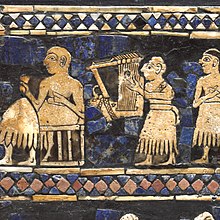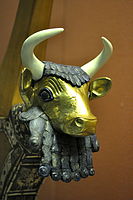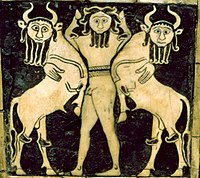Lyres of Ur



The Lyres of Ur or Harps of Ur is a group of four string instruments excavated in a fragmentary condition at the Royal Cemetery at Ur in modern Iraq from 1922 onwards. They date back to the Early Dynastic III Period of Mesopotamia, between about 2550 and 2450 BC, making them the world's oldest surviving stringed instruments.[1] Carefully restored and reconstructed, they are now divided between museums in Iraq, the United Kingdom, and the United States.
Strictly speaking, three lyres and one harp were unearthed, but all are often called lyres. The instrument remains were restored and distributed between the museums that took part in the excavations. The "Golden Lyre of Ur" or "Bull's Lyre", the finest, is in the
In 1929, archaeologists led by the British archaeologist
Leonard Woolley dug up the lyres from amongst the skeletons of ten women in the Royal Cemetery at Ur. One skeleton was even said to be lying against the lyre with her hand placed where the strings would have been.[4] Woolley was quick to pour in a liquid plaster to recover the delicate form of the wooden frame.[7] The wood of the lyres was decayed but since some were covered in nonperishable materials, like gold and silver, they were able to be taken.[8]
Lyres
A lyre is a musical instrument that is stringed and has a role projecting from the body. There are two types of lyres: box and bowl. Like their names suggest, the box lyres have a boxlike body and the bowl lyres have a round body with a curved back. The Lyres of Ur are box lyres. They were played in an upright position with the strings plucked with both hands.[9]
Because of their positioning in situ it is believed that the lyres were used in burial ceremonies in accompaniment to songs. Each lyre has 11 strings to play on that would produce a buzzing noise that is repeated throughout the song. The musician playing the instrument would repeat the pattern displayed on the lyre.
The four lyres
The "Golden Lyre of Ur" or "Bull's Lyre" is the finest lyre, and was given to the
The "Queen's Lyre" is one of two that Woolley removed from the grave of Queen
The "
The "Silver Lyre" is 110 cm (42 in) in height and 97 cm (38 in) in width. It is one of two silver lyres taken from the "Great Death Pit". Both lyres were made of wood and then covered in sheets of silver that were attached with small silver nails. The eyes are made of lapis lazuli and the lyre was also trimmed with narrow borders of lapis lazuli. This is the only lyre that is not bearded. Because of this fresh face some believe it is actually a cow rather than a bull. It is held by the British Museum.[15][16]
The
Gallery
-
Head of the "Bull Headed Lyre"
-
Plaque from the "Bull Headed Lyre"
-
Bull's head of the Queen's lyre from Pu-abi's grave PG 800, the Royal Cemetery at Ur, Southern Mesopotamia, Iraq. British Museum
-
Cow's head of the Silver Lyre, from the Great Death Pit at the Royal Cemetery, Ur, southern Mesopotamia, Iraq. The British Museum, London
-
Master of animals motif in a panel of the soundboard of the "Bull Headed Lyre"
-
The Golden Lyre from Woolley's published record
-
Leonard Woolley holding the hardened plaster mold of the Sumerian Queen's Lyre, 1922
See also
- Music of Mesopotamia
- Ninigizibara
- 1929 in archaeology
- Kinnor, ancient Hebrew form of a lyre or kithara
- Nevel, ancient Hebrew form of a harp or nabla
References
- ISBN 978-1-85984-005-4.
- ^ a b "Ancient Iraqi harp reproduced by Liverpool engineers" (Press release). University of Liverpool. 28 July 2005. Archived from the original on 1 July 2010. Retrieved 2009-11-23.
A team of engineers at the University of Liverpool has helped reproduce an ancient Iraqi harp - the Lyre of Ur
- ^ Taylor, Bill. "Golden Lyre of Ur". Archived from the original on 2011-06-11.
- ^ a b c d "Queen's Lyre". British Museum. Retrieved 2017-03-22.
- ^ a b "Lyre with bearded bull's head and inlaid panel". With Art Philadelphia. Retrieved 2015-09-26.
- ^ a b c Aruz, J.; Wallenfels (2003). Art of the First Cities: The third millennium B.C. from the Mediterranean to the Indus. New York, NY: The Metropolitan Museum of Art.
- ^ a b McTague, Carl. "The Lyre of Ur, Carl McTague". Mctague.org. Retrieved 2014-03-17.
- . Retrieved 21 October 2015.
- ^ "Encyclopedia Britannica Onlin". academic.eb.com e. Retrieved 2015-10-29.
- ^ "lyre-of-ur.com". lyre-of-ur.com. Retrieved 2014-03-17.
- S2CID 163583412. Retrieved 2014-03-17.
- ^ "Lyres from The Royal Tombs of Ur". Sumerian Shakespeare. Retrieved 2015-09-27.
- ^ a b de Schauensee, Maude. Two Lyres from Ur. Upenn.edu. Retrieved 2014-03-17.
- JSTOR 3180072.
- ^ "lyre". The British Museum. Retrieved 18 August 2022.
- ^ "Museum of the World: Silver lyre". Museum of the World. Retrieved 18 August 2022.







